Pathfinder expands Nissan’s midsize SUV presence
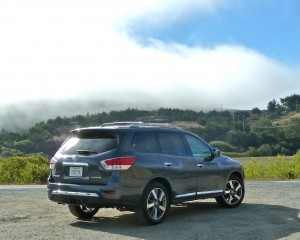
Larger, roomier Pathfinder adds comfort and convenience for 2013, as clouds roll in from San Francisco.
By John Gilbert
CALISTOGA, CALIF. — With so many sport-utility vehicles on the market, anything and everything is available, from 7-passenger family haulers, to off-roaders, to freeway cruisers, to sport and tow vehicles. Nissan makes SUVs for all those niches, but the fourth-generation 2013 Pathfinder will apparently attempt to cover all them in a single bound.
The 2013 model has a shapely form that bears little resemblance to the previous three generations, which spanned 26 years as solidly successful SUVs. The new one is longer, lower, wider and lighter, and takes the breed in a new direction with greater comfort, versatility, and better fuel economy.
The first Nissan Pathfinder was a sturdy all-terrain sport-utility vehicle that came out in 1986 and became an industry staple for 10 years. The second generation Pathfinder hit showrooms in 1996 and lasted until the third, which ran from 2005-2012. All of them maintained the family resemblance and were comfortable and efficient all-weather family vehicles.
The midsize SUV segment has made some major moves, however, capturing the younger family market where buyers are worried more about connectivity and amenities than they are in working only as a sportsman’s vehicle. It’s still fashionable to tow the fishing boat or camp trailer and cover the rugged road to the lake, but taking the kids and their teammates to practices, games, or out-of-town tournaments in comfort while watching DVDs or listening to MP3 music has taken on a greater importance.
“We think we’ve hit the sweet spot for people with families,” said Rich Miller, Nissan’s product manager for the U.S. and Canada. “For them, having two rows of seats might be too small, and having a third row that is readily accessible is important. We also wanted to maintain the power we have and the drivability, but we needed to improve our fuel economy. We also think our buyers will give up a little in towing for more fuel economy.”
At that, the Pathfinder still tows 5,000-pound trailers, although that’s down from 7,800. Two reasons for that: Nissan still sells the larger Armada with its V8 for heavy-duty towing, and the new Pathfinder gives up its previous 4.0-liter engine for the 3.5 V6, and uses front-wheel drive when it’s in 2-wheel-drive mode for the first time, compared to the previous rear-drive.
It’s possible that the popularity of the more compact Rogue, and the sporty Xterra justify enlarging the Pathfinder, which — market research notwithstanding — might capture buyers from compacts to full-size, from its enlarged midsize location.
“The new Pathfinder is more than 4 inches longer and wider, which gives us more room and better access to all three rows of seats,” said Miller. “The second row slides 5.5 inches forward, so even with a child seat latched onto the second row, it will still slide enough to allow easy access to the third row, which reclines.”
The basic Pathfinder S starts at $28,282 with 2WD, or $29,870 for 4WD; the upgraded SV starts at $31,530 2WD and $33,130 4WD; the fancier SL prices start at $34,470 with 2WD or $36,070 for 4WD; and the loaded Platinum opens at $39,170 for 2WD, or $40,770 with 4WD. The 2WD models have EPA fuel estimates of 20 city and 26 highway miles per gallon, while the AWD models rate 19/25. Those figures shwo highwayt estimates better than the competing Honda Pilot, toyota Highlander, Ford Explorer 3.5 V6, and th Chevrolet Traverse.
The first Pathfinder was body-on-frame for ruggedness. The second switched to unibody, and the third went back to the body-on-frame. The new Pathfinder goes back again to unibody, “because that’s where the segment is going,” said A.J. O’Shaughnessy, the senior planner on the vehicle.
“Using unibody design and more high-strength steel allowed us to make it 500 pounds lighter and still stiffer structurally with 60 percent improved rigidity. And we have a 20-25 percent improvement in fuel economy with our 3.5-liter V6. It has 260 horsepower and with its CVT we have a highway estimate of 26 miles per gallon.”
For its introductory drive route, we drove from the Solage Resort in Calistoga, Calif., through Napa Valley’s wine country and over some twisting mountain roads to the coastal Hwy. 1, I recorded 28.6 mpg, which is impressive considering its 26-mpg EPA highway estimate. Improvements in suspension and agility, plus its hydraulic/electric power steering and the lighter unibody all help make this possibly the best-handling Pathfinder yet.
Miller said Nissan did a lot of winter testing in Minnesota, in the Bemidji area, which also might have afforded the company a first-hand trial of some mild off-roading to the assorted lakes in Paul Bunyan land. We tried some off-road tests in the coastal mountain area, and IL was mildly impressed.
There is an excellent hill-start-up device, that prevents the Pathfinder from rolling backward if you’re on a steep hill, but there is no hill-descent control, which is extremely important for descending those same steep avenues, and moreso for coming down hills off-road. O’Shaughnessy said, “Our market research said people didn’t find hill-descent control important enough to ask for it.” Maybe there are so many features on the Pathfinder that the research subjects overlooked it, but when you have to drop the CVT (continuously variable transmission) down into its lowest range and still ride the brakes all the way down a hill, you can appreciate what hill-descent control can do.
Otherwise, feature content is unexcelled. Remote start, a dual panorama sunroof, an 8-inch navigation screen with four times better resolution, rear dual 7-inch screens for DVDs, games, etc. Along with the hill-start assist, the dampers have built-in rebound springs for improved stability and handling. And two of the outstanding Nissan innovations are present on the Pathfinder.
First is the easy-fill tire alert, which not only indicates when you have a tire that is low on air pressure, but when you find a place to fill it with air, an alert sounds to indicate you’ve filled it to the specified level.
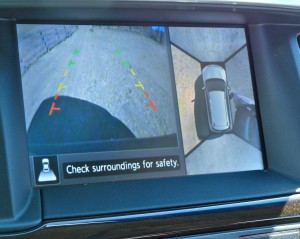
Back-up camera is joined by remarkable Nissan top-view look at Pathfinder to avoid obstructions all around.
Another amazing feature is that Nissan goes far beyond the normal back-up rear camera to an around-view monitor. A system of four cameras located all around the Pathfinder somehow conspire by computer to show a top-down view of the vehicle, so you can see any and all obstructions all around you. The screen shows an image of your Pathfinder almost as if someone is out there hovering above you, shooting down on your vehicle.
The CVT operates by a chain rather than a belt, which helps durability. And the Xtronic CVT has a wider gear range, aimed at offering optimal gearing for towing and highway cruising. An adjustment button offers 2-wheel drive, automatic 4-wheel drive, and a locking 4WD that can afford the ability to spin and churn with all four wheels simultaneously for deep snow or mud. There also is intuitive 4WD with a torque split in Drive Assist, and All-mode 4×4.
The actual dimensions show a 196.9-inch length (+4.6 from the 2012 model), 114.2-inch wheelbase (+2.0), 77.1-inch width (+4.3), and 69.6-inch height (-3). The vehicle’s 0.34 coefficient of drag is a 13-percent improvement.
The Pathfinder is intended to be a global vehicle, designed at the LaJolla, Calif., studio, with engine technology from Nissan’s Detroit tech center, and it will be built in Smyrna, Tenn., which will increase capacity by moving the Altima, Xterra and Frontier to Canton, Miss.
After we finished the off-road testing, a Pathfinder was shuttling me back to the lunch location, and a fairly large Nissan worker wanted to catch a ride. When he saw the front seats occupied, while I was trying out the spacious rear seat, and the demonstration child seat fastened in the other rear seat, he said it was OK, he’d walk. I jumped out, and told him that since so much was made of the accessibility of the third-row seat, he should try it. He had no choice but to slide the seat forward and climb in, quite easily I must say, and he insisted there was more than adequate room back there.
Comments
Tell me what you're thinking...
and oh, if you want a pic to show with your comment, go get a gravatar!


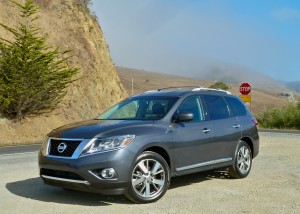
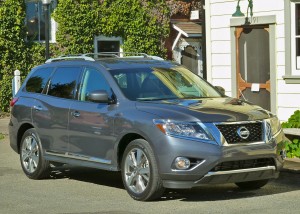
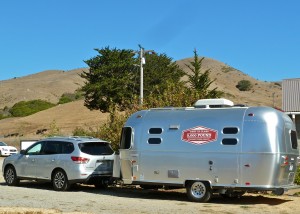
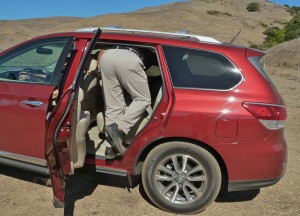
 John Gilbert is a lifetime Minnesotan and career journalist, specializing in cars and sports during and since spending 30 years at the Minneapolis Tribune, now the Star Tribune. More recently, he has continued translating the high-tech world of autos and sharing his passionate insights as a freelance writer/photographer/broadcaster. A member of the prestigious North American Car and Truck of the Year jury since 1993. John can be heard Monday-Friday from 9-11am on 610 KDAL(www.kdal610.com) on the "John Gilbert Show," and writes a column in the Duluth Reader.
John Gilbert is a lifetime Minnesotan and career journalist, specializing in cars and sports during and since spending 30 years at the Minneapolis Tribune, now the Star Tribune. More recently, he has continued translating the high-tech world of autos and sharing his passionate insights as a freelance writer/photographer/broadcaster. A member of the prestigious North American Car and Truck of the Year jury since 1993. John can be heard Monday-Friday from 9-11am on 610 KDAL(www.kdal610.com) on the "John Gilbert Show," and writes a column in the Duluth Reader.